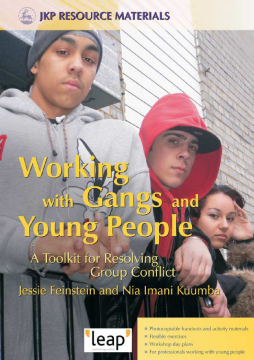
Additional Information
Book Details
Abstract
Concern about gang culture is on the increase, but remains surrounded by myths. While gangs may lead young people into dangerous situations and breed community division, distrust and fear, the friendship, support, security and sense of belonging they offer are often overlooked by those working with young people involved in gangs.
Working with Gangs and Young People demonstrates how young people can be engaged in a creative and challenging process that explores the costs, gains and consequences of the choices they make around their gang membership. It provides a tried-and-tested training programme for anyone involved in conflict resolution with young people in groups or gangs, and offers effective interventions that work.
Based on a five-year action research project developed by Leap Confronting Conflict, this practical, fully photocopiable toolkit gives practitioners the materials, support and inspiration needed to engage young people who are involved in gangs. It presents flexible activities and strategies to run either two-hour or one-day workshops, and will be indispensable to anyone involved in working with this under-supported group.
This book will be particularly useful for professionals working with young people who are involved in street gangs, and for organisations considering their strategy to manage gangs. This book provides both a set of resources for a prevention or low-intensity intervention course, as well as proving a starting point for further development. It also has a wider achievement in clearly presenting the possibility of broadening gang strategy from suppression to include prevention and intervention.
Prison Service Journal
Working with Gangs and Young People is very useful handbook to getting young people to explore the concept of gangs and the criteria of membership. The book clearly sets out a training programme for those working with at risk young people, to help them explore the consequences of their actions.
Child Right
Jessie Feinstein has been working with young people in gangs since 1994. She worked in the US with young people in custody, often due to gang involvement, and subsequently has worked throughout the UK with gang members and the adults that work with them. Nia Imani Kuumba has worked with young people and professionals in the Caribbean, Europe and the US since 1984, and is a senior trainer in conflict resolution. Jessie and Nia have been working on Leap's Gangs and Territorialism Programme since 2001 and continue to set up training programmes for both adults and gang members. These programmes were developed based on the experiences of young gang members throughout the UK and successful interventions in the UK, USA and mainland Europe.
Leap Confronting Conflict is a national voluntary youth organisation and registered charity providing opportunities, regionally and nationally, for young people and adults to explore creative approaches to conflicts in their lives.
Described as a toolkit for resolving group conflict, this book aims to help youth workers engage young people who are involved in gangs. Its authors have years of experience of working with young gangs and the book is based on extensive research by the youth project Leap Confronting Conflict. It includes advice on bringing rival gangs together and contains various games designed to engage young people and make them think about their involvement in gangs.
Children Now
Based on a five year old action research project developed by Leap Confronting Conflict, this is a fully photocopiable toolkit which aims to give practitioners the materials, support and inspiration needed to engage young people who are involved in gangs. It demonstrates how young people can be drawn into a creative and challenging process that explores the costs, gains and consequences of the choices they make in relation to gang membership. Using a tried and tested programme, the book sets out to present flexible activities and stragegies to run either two-hour or one-day workshops.
Human Givens Magazine
This publication is a welcome contribution to the hands-on conflict resolution literature dealing with youth and street gangs. It comes at a time when many local communities are wondering how to respond to young people participating in rapidly mutating street subcultures that have both violent and non-violent elements and which derive from both U.S. and British traditions… Based on years of practice and experience with street groups, the lessons collected in this book will be an indispensable guide to youth workers, community organizers, teachers and social workers in their search for effective, humanistic responses to gang-related tensions and anti-social behavior.
Dave Brotherton, Professor and Chair, Department of Sociology John Jay College of Criminal Justice/City University of New York
Working with Gangs and Young People is an excellent toolkit for practitioners, whether or not they are working with high-risk young people. It goes a long way towards empowering workers with the confidence needed to engage in group activities and discussions with young people. The activities will enable young people to understand what is going on in their lives and to positively take control of the decisions and issues that affect them.
Rubel Ahmed
Table of Contents
| Section Title | Page | Action | Price |
|---|---|---|---|
| 1. Inequality explored | |||
| 2. Redistributing power | |||
| 3. Sharing wealth | |||
| 4. Reducing fear and anxiety | |||
| 5. Changing the rules | |||
| 6. Let's get urgent |
